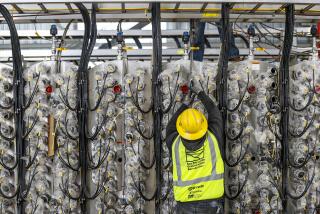Pasadena Will Test Innovative Method of Water Purification
PASADENA â Cleaning ground water contaminated with volatile organic chemicals has long been akin to robbing Peter to pay Paul.
Water can be purified, but current technology requires blowing contaminants into the atmosphere or transferring them to carbon filters, which eventually must be buried in toxic-waste landfills.
But starting next month, Pasadena will begin a 6-month test of an innovative process that may provide a clean and efficient method of purifying contaminated water.
If successful, the test could have a major impact on efforts to clean up the vast amounts of polluted ground water that plague the San Gabriel Valley and other parts of the country.
âIf we find something positive, the implications are tremendous,â said E. Marco Aieta, applied research department manager for James M. Montgomery, Consulting Engineers Inc., which is conducting the test for the city.
The $165,000 experiment also is unusual because of the partnership with Jet Propulsion Laboratory, the probable source of the contamination that has forced the closure of four water wells in northwest Pasadena.
JPL has agreed to pay about $31,000 of the test costs and a substantial portion of the eventual construction and operating costs of a permanent purification facility.
âWe havenât worked out the details, but we have committed to playing a significant role,â said Clarence Gates, associate director of JPL. âIt has been a very congenial arrangement, and I donât foresee any problems.â
The city will provide about $31,000, and the Lincoln Avenue Water Co., which owns two of the closed wells, will provide about $3,000.
The American Water Works Assn. Research Foundation, a Denver-based group that funds innovative water treatment programs, will provide the remaining $100,000 to help conduct the test.
The experiment will combine air stripping, a proven method of removing volatile organic chemicals, with a new process using ultraviolet light, ozone and hydrogen peroxide that officials hope will destroy 99% of the contaminants.
Air stripping is used in at least 200 facilities around the country to clean contaminated water.
The process works by cascading water down a tower filled with a packing material that distributes the water and breaks it down into a thin film. As the water tumbles down, large volumes of air are pumped up.
The air literally blows the organic chemicals--perchloroethylene (PCE), trichloroethylene (TCE) and carbon tetrachloride (CTC)--out of the water. Those chemicals are common components of industrial solvents and are suspected of being carcinogenic.
The method is effective but has been criticized because pollutants are released into the atmosphere.
âAir stripping will clean the water, but how do you clean the air?â asked Thomas K. Underbrink, the cityâs water engineering manager. âWeâre not going to blow this stuff into somebodyâs second-story window.â
The experiment has taken on added importance because the South Coast Air Quality Management District has adopted a rule to limit emissions from air-stripping towers starting in December.
Ignore Effects on Cleanup
The Upper San Gabriel Valley Municipal Water District, whose office is in El Monte, filed suit in February, accusing the AQMD of ignoring the effects on ground-water cleanup efforts. A Los Angeles Superior Court judge has just ordered AQMD to conduct an environmental impact study before imposing restrictions on the air-stripping towers.
One method of purifying the gases before they are released into the atmosphere is using carbon filters. But the filters are expensive, and many criticize the process because it creates another hazardous waste: the filters themselves.
Pasadenaâs experiment will test the ability of ultraviolet light, ozone and hydrogen peroxide to destroy the contaminating gases.
Emissions from the tower will be routed to a sealed unit that has one or several ultraviolet bulbs inside.
At the same time, ozone, hydrogen peroxide or a combination of the two will be pumped in and mixed with the contaminated air.
It is hoped that the ultraviolet light and the two gases will break down the volatile organic chemicals into harmless carbon dioxide, water vapor and chloride, which can then be discharged.
The experiment is the cityâs second try at finding a way to purify ground water.
The first test involved directly treating contaminated water with ultraviolet light and ozone without air stripping, Underbrink said.
The technique had been successfully used to purify extremely contaminated water at aerospace, automobile and semiconductor plants around the country, he said.
But although the UV-Ozone process removed nearly all of the contaminating organic chemicals, it was unable to destroy more than 80% of the carbon tetrachloride in the water.
Inhibited Destruction
Underbrink said test results suggested that the water inhibited destruction of the chemical. The failure led consulting engineers to propose using ultraviolet light, ozone and hydrogen peroxide on gas emissions, rather than water. Aieta said purifying the gases should be easier than treating the water directly.
âAll the experts say there is a good chance of it working, but we really donât know because it has never been done before,â Underbrink said.
The cityâs search for a way to purify ground water has reached a critical stage because of the continuing spread of contamination through an underground depression in northwest Pasadena called the Monk Hill sub-area.
Tests of drinking water wells in 1979 at first revealed that only one well located a few hundred feet from JPL was contaminated with trichloroethylene.
But since then, the contamination has spread to three other wells in the area, all of which have been closed.
JPL, which has admitted that it is the probable source of the contamination, routinely dumped volatile organic chemicals in an underground cesspool from the early 1940s to as late as 1962.
The use of cesspools was considered safe at the time because it was widely believed that the chemicals would break down into harmless components before reaching the ground water.
That changed in 1979, when significant quantities of the chemicals were found in ground water near an Azusa industrial complex.
In the last few years, contamination above levels deemed acceptable by the state has been found in about 135 wells in the San Gabriel and San Fernando valleys.
The U.S. Environmental Protection Agency has estimated that it may cost $800 million and take 50 years to clean up just the San Gabriel Valley, which was put on its Superfund list in 1984.
If the experiment is successful, the city hopes to build a permanent facility, capable of treating 4,400 gallons of water a minute, by late 1990.
âWe know it is spreading,â Underbrink said of the contamination. âWe canât wait longer than two years.â
Underbrink said it would cost $1.9 million to build a permanent treatment plant located off Windsor Avenue, south of Mountain View Street.
If the test fails, the city will use the carbon filtering system to purify emissions from air-stripping towers.
Although carbon filtration is not the most environmentally desirable method, Underbrink said the city has run out of time to test other new technologies.
âAt least we will have given our best shot at coming up with something better,â he said.
EXPERIMENTAL WATER TREATMENT PROCESS Contaminated water would be purified in a two-way process:
The water is pumped into the tower through a pipe at the top and hits the distributor plate, which spreads it evenly through the tower. The water goes down through the packing, is cleaned by air being forced up and once cleaned, is routed out through a pipe at the bottom.
Meanwhile, the air is being forced up from the bottom of the tower, cleaning the cascading water by absorbing the chemicals trichloroethylene (TCE), perchloroethylene (PCE)and carbon tetrachloride (CTC). The now-contaminated air is sent to the emissions treatment unit, where it is exposed to ultraviolet light and treated with ozone and/or hydrogen peroxide to break down the chemicals. The gases are then routed out of the treatment unit. The final byproducts are carbon dioxide, water vapor and chloride ions, which are all harmless.
Source: James M. Montgomery, Consulting Engineers Inc.
More to Read
Sign up for Essential California
The most important California stories and recommendations in your inbox every morning.
You may occasionally receive promotional content from the Los Angeles Times.











